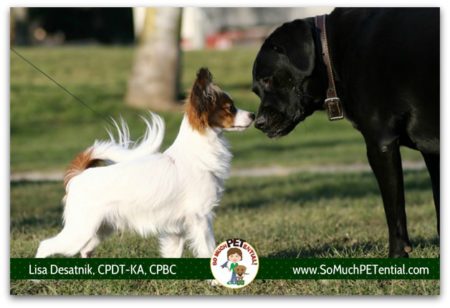I was at a park the other day when I saw a mother and her two children walking their goldendoodle puppy, a 40 to 50 pound teddy bear who very clearly found interest in everything going on around them. I knew that by seeing his alertness in looking around, his tail held high or wagging, and his sniffing everything in site. The only thing holding him back was a couple of young humans pulling back on the other end of a leash.
A man with another small dog happened to walk by and the puppy’s strength won out against the will of the children as they moved forward, a very taught long piece of nylon fabric keeping them together. As the puppy got closer, the small dog began looking away, lip licking, then taking a step away with taught body muscles and a tail tucked between his back legs. I could tell this was not going to be a very pleasant greeting, at least for the small dog. Still, the goldendoodle persisted in moving his humans forward.
When I mentioned to the mother that the small dog wanted space, she told me her puppy was just being friendly and wanted to say hello. I pointed out the body language on the other dog and this time more strongly suggested they move away before the two dogs made contact. They did. And they each went on their way. I am not sure if what I said to them will have an impact on their future outings, but I hope it will.
I thought I would write about this in hope that it may at least help others in understanding how to help their dogs have pleasant on leash experiences.
The fact is that when unfamiliar dogs are on leash – or d ogs who are familiar but who have very different greeting skills and behaviors – things have the potential to go downhill very quickly.
ogs who are familiar but who have very different greeting skills and behaviors – things have the potential to go downhill very quickly.
Dog greetings on leash – what can happen:
Think about how dogs typically greet each other in a calm situation when they are off leash. A positive greeting is one in which the dogs would approach each other with loose body muscles, moving to each other’s side with head down slightly as they sniff the rear end of the other dog.
But when a dog walks toward the other with a taught leash around his neck holding him back while his tail is held high, his arousal is heightening as he gets closer. Both dogs may be restricted by taught leashes, and as they move to each other their muscles tighten more. (The leash restriction also does not allow them to get distance from each other.) They may either greet face on fixated on each other, which is a sign of impending danger and tension. Or they may lean or look away with lip licks, ears down, tense mouths, or other body language indicating discomfort and stress. One or both could also become overly excited jumping on the other, which is very rude behavior among dogs, and if the other is indicating stress signals that are ignored that could mean trouble. What all of these greetings have in common is the fact that close proximity in that moment could easily erupt into a negative confrontation such as barking, lunging, snarling, or worse in a split second. Human may react by jerking on leashes, yelling, forcing their dog into a sit or down position or worse. If an eruption does not occur, dogs still may be showing body language of stress that may go missed by their humans. And dogs will ultimately learn from their experience that negative consequences occur when on leash around other dogs (and/or even humans). Or another consequence could be that the dog (s) is getting reinforced for inappropriate behavior, and we know that reinforced behavior continues and even strengthens.
Training and helping your dog with dog greetings and socialization:
The safest solution is to avoid on-leash greetings among unfamiliar dogs because even if you have done everything right in terms of teaching your dog behaviors and knowing how your dog communicates, you can not predict what the other dog will do. Especially if you see the other dog pulling on a leash to get closer, you know that is a dog who is not focused on paying attention to his handler while his arousal is heightening.
Some foundational skills to teach your dog as incompatible behaviors to pulling on leashes toward any stimulus are attention, walking by your side, emergency u-turn, recall, leave it, or sitting (although be careful to ask your dog to sit in a situation that is scary and uncomfortable).
Learn dog body language to recognize when your dog is relaxed, excited, nervous, or stressed; and when to give your dog distance from whatever it is that is causing that reaction.
Have ‘safe’ off leash play sessions with dogs you know will play well with your dog, who can play together with breaks.
Practice walking on leash parallel to another dog while your dog can have loose body muscles, and walk near you.
Around your dog’s ‘friends’, practice ‘safe’ leash greetings and work in proximity to each other on leash, with those foundational skills. Teach your dogs to approach each other with a loose leash, to sit at your side when you are close to each other, and walk away after just a second or two.
And never forget to put play into every day!






